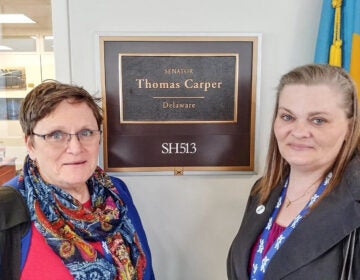Bucks-Montco group joins nationwide petition to designate PFAS as hazardous waste
The petition demands that EPA designate the chemicals under the Resource Conservation and Recovery Act, to ensure strict storage, transfer and disposal.

PFAS are toxic chemicals commonly found in clothing and non-stick cookware like teflon. (Wallace McKelvey/PennLive)
Updated 1:41 p.m.
Thousands of residents from Bucks and Montgomery counties have joined communities across the country in a national petition demanding that the Environmental Protection Agency regulate a toxic class of chemicals known as PFAS.
The petition demands that the EPA list dozens of the chemicals as hazardous waste under the Resource Conservation and Recovery Act to ensure that they are subject to strict storage, transfer and disposal.
Bucks and Montgomery counties have been heavily exposed to the chemicals, which were present in firefighting foam used on former military air bases in Horsham and Warminster. PFAS contamination was detected in 2014 in water supplies serving more than 70,000 residents.
Although their impact on human health is still under investigation, the petition says that “exposure to certain PFAS has been associated with liver damage, high cholesterol, obesity, diabetes, cancer, thyroid disease, asthma, immune system dysfunction, reduced fertility, low birth weight, and effects on children’s cognitive and neurobehavioral development.”
“It’s a national crisis, and it’s a state of emergency, and we’re seeing PFAS everywhere … in pizza boxes, in makeup, in tampons,” said Hope Grosse, cofounder of the Buxmont Coalition for Safer Water. Grosse grew up in Warminster near one of the air bases. She had cancer at 25, and her father died of cancer.
“We need to hold the polluters accountable, and we need these chemicals to stop being dumped in the environment by either businesses or the Department of Defense,” said Grosse, who has been fighting to regulate the chemicals for years.
PFAS are present in a variety of commercial and industrial products, including flame retardants, nonstick cookware, greaseproof food wrapping, and waterproof textiles. Because they don’t break down, the chemicals, if not contained, eventually leach into soil and groundwater, contaminating drinking water supplies.
“We know that when PFAS is disposed of in a traditional municipal landfill, that it leaks in the waterways. That’s been proven throughout the country. So that’s why it needs to be regulated as hazardous so it’s in landfills where it won’t leak back into the water,” said Tim Whitehouse, executive director of Public Employees for Environmental Responsibility and a former senior attorney at the EPA, where he worked in enforcement of the Clean Water Act and on hazardous-waste compliance issues for 10 years.
The petition is an initiative of the Green Science Policy Institute, a nonprofit scientific organization based in Berkeley, California, and it includes grassroots organizations representing communities affected by PFAS contamination in the Arctic, North Carolina, Michigan, Colorado and the Philadelphia region.
“The U.S. EPA has been very slow to set any sort of national standards — we don’t have mandatory standards for PFAS in drinking water and, the subject of our petition, we’re not actually managing all of these PFAS waste as if they are actually hazardous, which they are,” said Claudia Polsky, director of the Environmental Law Clinic at the University of California, Berkeley, which is representing the petitioners.
On Thursday, Molly Block, a representative from the EPA, said in an email that the agency has not yet received the petition. Block added that although PFAS are not defined as a hazardous waste federally, “states may be more stringent/broader-in-scope in their authorized hazardous waste programs.”
“Over the next year, as required under the National Defense Authorization Act for Fiscal Year 2020, EPA will be issuing interim guidance on the destruction and disposal of PFAS and materials containing PFAS substances,” Block said.
On Friday, the U.S. House of Representatives passed, with some bipartisan support, a bill calling for regulation of some PFAS chemicals. But President Donald Trump has said he will veto the measure should it pass the Senate.
Polsky said the “forever chemicals” (as PFAS have been called because of their persistence) listed in the petition meet all the criteria set by the EPA for them to be regulated as hazardous. Listing the chemicals under the Resource Conservation and Recovery Act would automatically designate them as hazardous substances under the Superfund law, making polluters liable for cleaning up drinking water and the environment.
“If we dump PFAS in unlined landfills, if we incinerate PFAS and they’re not well combusted and they end up on land and draining to surface water, all of those things are going to come back in the tap,” Polsky said.
Although the citizen petition doesn’t give the EPA a specific time frame in which to grant or deny its demand, Polsky said a separate law, the Administrative Procedure Act, could allow the petitioners to take the agency to court seeking a decision.
“Declaring PFAS a hazardous substance allows us to hold PFAS polluters accountable and releases money for its cleanup,” said Joanne Stanton, co-founder of the Buxmont Coalition for Safer Water. “Locally, we still have contamination in the environment with uncontained PFAS plumes at the site of both bases that threaten clean drinking water sources and private well owners,”
Grosse said joining a national coalition will allow their community to share information, gain knowledge, and raise awareness of the issue.
“I don’t believe that a small community can fight this alone,” she said. “We’re not going to change the past, but we can change the future.”
WHYY is your source for fact-based, in-depth journalism and information. As a nonprofit organization, we rely on financial support from readers like you. Please give today.





